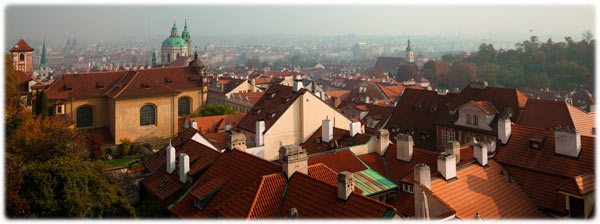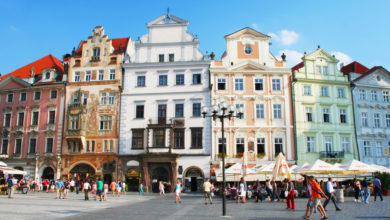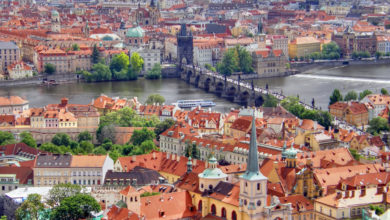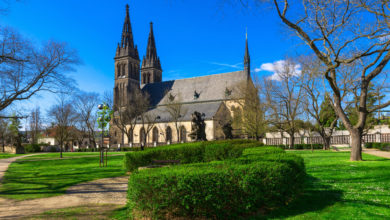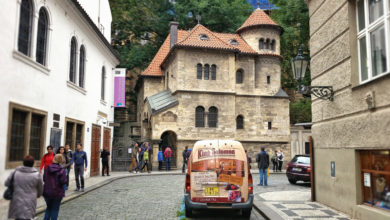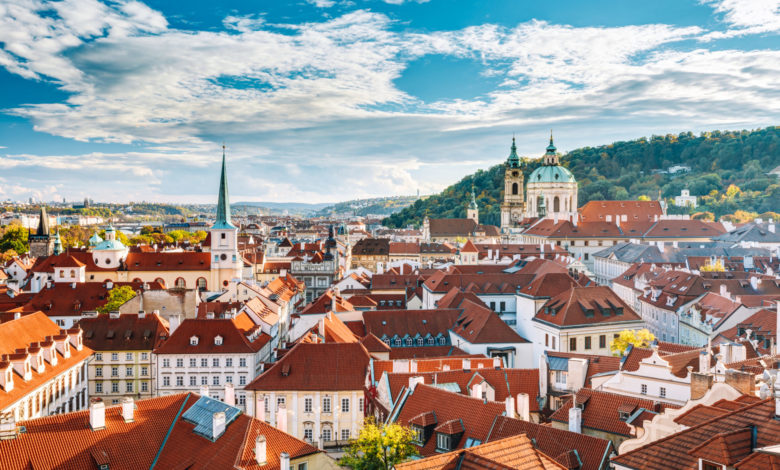
It may be translated as the ‘Lesser Town’ in English, but don’t be fooled – Malá Strana is one of Prague’s foremost attractions.
Formally established as a town in 1257, it grew rapidly during the reign of Charles IV, who enlarged it and built state-of-the-art fortifications. In the 16th century, the area rose from the ashes of two great fires to become one of Europe’s great cultural centres, with a plethora of noble residents moving in and a wealth of magnificent Baroque churches being built in the neighbourhood – the highlight of which is the spectacular St. Nicholas Church, built by three generations of the Dientzenhofer family.
When the centre of political power moved to Vienna in the 17th century, the nobility left town and the area reverted to local craftsmen and the poor. However, this was a blessing in disguise, as the building boom of the 19th and 20th centuries passed it by, allowing it to retain its historic character through the ages. And today, with its ocean of red-tiled roofs, cobbled back streets, luxurious regal palaces and grand historic churches, all watched over by the magnificent Prague Castle, Malá Strana is one of the Czech capital’s most picturesque neighbourhoods… with a great deal to offer tourists.
 Length
Length
Approx. 2 km (1.25 miles). The walk, excluding interior attractions, takes around 90 minutes.
Starting Point
The castle viewpoint. Getting there: Take Line A to Malostranská metro station, then Tram 22 to either Pražský hrad or Pohořelec, and walk to the lookout. You’ll finish by Charles Bridge.
Stopping-off Points
You’ll find great cafés and restaurants offering light refreshments throughout the neighbourhood, but they’re mostly clustered around Malostranské náměstí and right along Nerudova.
The below-listed tour can be walked on your own (self-guided tour), or we can arrange for you a professional English-speaking guide. The tour guide can even tailor this walk to your special needs. For example, recommend a place to stop for lunch, including a river cruise or tram ride if you are tired walking, etc. The guide can pick you up at your hotel, or you can arrange to meet anywhere in the city. Please email us your details for a price quote.
1. Prague Castle viewpoint. The tour begins just south (to the right) of Prague’s Castle’s main gate, which boasts one of the finest views in the city. From here, you can look out across Malá Strana – drinking in the grand dome of St. Nicholas Church, the pretty spire of the Church of Our Lady Victorious and a cascade of beautiful red-roofed residences – and beyond, over the Vltava, to see the Old Town, the New Town and more.
Some sights worth looking out for on the horizon include Žižkov TV Tower (a tall, needle-like tower which was built in the 1980s and which – as people with exceptional eyesight may notice – is now adorned with a series of crawling, faceless, babies added by art prankster David Černý), Vyšehrad (a historic cathedral and fortification that pre-dates Prague Castle), the Powder Tower (a spectacular Gothic structure that was once the main gate to the medieval walled gates) and more besides. You will also get a great sense of why the Czech capital is often known as the ‘City of a Thousand Spires’.
2. Ke Hradu to Nerudova. From the Prague Castle viewpoint, you’ll head down the short cobblestone street Ke Hradu – turn left at the bottom of the large stairway, and you will emerge on the bustling tourist street of Nerudova. Named after the renowned 19th-century poet and journalist Jan Neruda – who wrote a popular collection of short stories entitled (in English) ‘The Lesser Town Tales’ – this street has seen dozens of grand, regal processions in its time, with everybody from Bohemian Kings to Holy Roman Emperors to Communist leaders heading up Nerudova en route to Prague Castle.
The very first thing you’ll see when you emerge onto the street is a large plaque commemorating one of the city’s darkest incidents. In 1948, many students marched along the street in protest against the new communist regime. They were met with a solid wall of armed police who immediately began to attack and beat them – a tragic harbinger for the 40 years of oppression that lay ahead. It’s a disconcerting introduction to an otherwise pleasant street but a potent and important reminder of the ongoing struggle for freedom and how much Prague has changed since the Velvet Revolution.
3. Continuing down Nerudova. As you continue down the street, you’ll notice that Nerudova boasts an appealing assortment of little old burgher houses, which are now mostly occupied by quaint souvenir shops and cosy restaurants – but look closer. You’ll also see that none of the houses has numbers. You see, house numbering is only a recent innovation in Prague – they were only introduced in 1770 – and before house signs above the main door distinguished those buildings. So as you walk along this ancient walkway, you will see many curious sets of symbols above doorways that correspond to the building’s name.
For example, at number 47, you’ll find a frieze containing two rather grumpy looking suns… and this is known, predictably, as ‘The House of the Two Suns’. It also happens to be where Jan Neruda lived for most of his life until he moved a few doors down the street to the House of the Three Black Eagles. Continue down Nerudova, and you’ll come across many other impressive historic house signs too: the House of the Red Lion (no. 41), which depicts a red lion holding a golden cup in his paw and was the home of the church painter Petr Brandl; the House of the Golden Lion (no. 32), which is now home to a historical pharmacy exhibition; and the House of the Three Fiddles (no. 12), which is where three families of violin-makers lived. And there are more too… see if you can spot the Houses of the White Swan (no. 49), the Green Lobster (no. 43), the Golden Horseshoe (no. 34) and the Red Eagle (no. 6).
At the bottom of the street, you will see a series of buildings designed by the renowned 18th-century Italian architect Giovanni Santini. In particular, keep an eye out for Thun Hohenstein Palace (no. 20), with the fierce eagles guarding the door, and Morzin Palace (no. 5), where you’ll see a pair of Moors carrying the balcony on their backs. These are now the Italian and Romanian embassies, respectively.
4. Malostranské Náměstí – Upper Square. As you come to the bottom of Nerudova, you’ll see that the street opens up into the upper part of a large square: Malostranské Náměstí. The square is dominated – and divided – by the not-too-shabby St. Nicholas Church. The main feature of the ‘upper square’, apart from some lovely theatres and interesting museums, is the large plague column outside the church entrance.
And this column is distinctive for two reasons. The first is that it isn’t, as you would probably expect, a memorial to those who died in the plague, but rather a message of thanksgiving for the survivors of the epidemic. And secondly, the top of the statue is not home to the Virgin Mary, which is common for these columns but instead has statues of the Holy Trinity. This is a direct message to God.
Now, take a quick look behind you, and you’ll see a stunning blue-and-cream building called Lichtenstein Palace (no. 13). This is very significant in the history of the Czech capital because it was once home to Karel I, Prince of Lichtenstein. Also known as ‘Bloody Lichtenstein’, the prince was sentenced to death by the 27 Hussite leaders of the Battle of the White Mountain. You may already have seen the 27 white crosses in the Old Town Square, which mark the place where they were killed, but it was here that they were sentenced – and that is marked by the 27 cast-iron heads mounted on a row of posts in front of the house. Since the 17th century, the building has been used for various purposes – from a post office to a military barracks – but today, it’s home to the Academy of Performing Arts’s music school, making it the perfect place to see excellent classical music concerts on the cheap!
5. St. Nicholas Church. From the upper square, there’s only one logical place to go next… into St. Nicholas Church. A genuine Baroque masterpiece and the perfect counterpoint to the Gothic St. Vitus Cathedral towering above, the Catholic church was commissioned following the defeat of the Hussites in the Battle of the White Mountain (1620). The main nave of the church was constructed between 1703 and 1711 by Krzštof Dientzenhofer, while the iconic dome was added by his son Kilián Ignác Dientzenhofer 25 years later, and the bell tower was added in the 1750s by Kilián’s son-in-law Anselmo Lurago. So this magnificent building was, in essence, a family project. For an additional fee, it’s well worth heading up Lurago’s bell tower for an amazing view of Prague, as well as a fascinating exhibition about how the police used the tower to spy on ‘subversive elements’ – and foreign embassies – during Communist times.
But back to the nave. The first thing that will strike you when you enter St. Nicholas Church is the enormous fresco on the ceiling: it depicts the life of (you guessed it!) St. Nicholas and is reputed to be one of the large in-situ paintings in the whole of Europe. And the rest of the interior is no less impressive either, with an incredible collection of statues, frescoes, and side alters all dripping with gold and precious metals. You can also head up to the balcony for a fresh perspective on the place.
One of the church’s most significant ‘claims to fame is that Wolfgang Amadeus Mozart loved to play the organ here – in fact, after his death, throngs of residents gathered here for an impromptu memorial service – and so during the summer evenings, you’ll often find Mozart recitals inside the church. If you still have an evening in Prague that’s unaccounted for, these are always exceptional.
6. Malostranské Náměstí – Lower Square. Turn left when you exit the church and head down the street at the side (it’s adorned with rows of excellent cafés and restaurants tucked under a colonnade, which are ideal stops for lunch), and you will emerge into the Malostranské Náměstí’s ‘lower square’. Home to a beautifully unusual blend of Renaissance and Baroque architecture – you can thank the two devastating fires in the 16th century for that – this juxtaposition is most evident if you look at the contrasting styles of house numbers 22 and 23. You’ll also find individual buildings which combine both architectural styles… most notably the building facing the square at the corner of Tomášská street (Tomášská no. 1), which has majestic Renaissance-style archways, windows and sgraffito, but is topped by a distinctly Baroque pediment.
7. St. Thomas and St. Joseph. If you cross the tram lines in the square and leave it to the east, on Letenská, you will pass two of Prague’s loveliest lesser-known churches. First up, and almost immediately, you will come across a small alley off to the left, which leads to St. Thomas Church. Founded by Augustinian Hermits in 1285, it was a part of a large monastery complex (including a brewery!) for many years before a major Baroque makeover by the Dientzenhofer clan during the 1720s. Today, it’s home to one of the most impressive choir lofts in the city, as well as copies of two paintings by Rubens, which are flanking the main altar (just in case you can’t make it to the National Gallery to see the originals!)
Then, just a few steps further down Letenská, there’s another side street off to the right (Josefská), which takes you to St. Joseph Church. The tall and ornate façade, which combines Dutch and Italian elements, is equalled by the beautiful white marble interior with golden side altars and high pillars.
8. The Wallenstein Gardens and Palace. Continue along Letenská – very carefully, as the pavements are narrow and the cars and trams that are jostling for space won’t slow down for pedestrians – and you’ll soon find yourself standing outside the rather nondescript entrance to the remarkable Wallenstein Gardens. And, unless you’re there in the winter, you can push it open to walk into one of Europe’s most majestic and hidden city parks.
A real ego exercise by the military commander Albrecht of Wallenstein, these 17th-century formal gardens, has everything you could desire, including landscaped lawns, sculpted trees, ornate fountains, and grotto walls… even a large aviary (which is home to a wonderful collection of owls). There’s also rather special statuary here. However, it’s a copy of the original version that the Swedes stole in 1648 (when, recently, the Czechs officially asked Sweden to return it, they laughed and declined). The west end of the gardens is dominated by an enormous triple-arched sala terrena, where concerts are held during the summer… and if this provides the entrance to the palace itself.
In keeping with the rest of Malá Strana, the Wallenstein Palace complex is a real mix of Renaissance and Baroque architectural styles. It’s also enormous – Abrecht demolished 23 houses to make space for his project, which he wanted to rival Prague Castle and hired Italy’s finest architects to design and build the house. He then, despite the lack of any permanent residents, employed 700 staff to run it! Today the palace is put to better use, housing the administrative offices of the Czech Parliament.
9. The Kafka Museum. Once you’ve finished with the Wallenstein Palace, head out of the gardens the way you came in and continue along Letenská until you get to a crossroads. Here, turn right onto U Ležického Semináře and, when the street forks, bear left onto Cihelná. This will bring you to the excellent Kafka Museum.
Probably the Czech Republic’s most famous literary figure, Franz Kafka was born in 1883 in a house right on Prague’s Old Town Square and lived in the city for most of his life – so it’s no surprise that there’s a museum dedicated to his life and work. What is surprising is that it only opened in 2005.
The museum showcases a wide variety of interesting exhibits related to Kafka, including several first editions of his books, a plethora of notes and manuscripts, lots of personal effects (including letters, diaries, photographs and drawings) and the odd audiovisual exhibit. Yet, in reality, many people don’t come here for Kafka at all – they come to see David Černý’s absurd sculpture in the courtyard. When the museum opened, the artist (who’s also known for the crawling babies on Žižkov TV tower and the dying horse pastiche in Palác Lucerna) installed a sculpture of two men joyfully peeing into a fountain shaped like the Czech Republic – and it’s been a smash hit. Why? Well, look around, and you’ll find a mobile phone number…. text your message to it, and the sculptures will spell it out for you in ‘urine’.
10. Kafka Museum to Charles Bridge. After you’ve spent hours playing with the fountain, walk out of the Kafka Museum courtyard and then turn left back onto U Ležického Semináře. As you’re walking along, look out for Shakespeare a Synové (no. 10), which is one of the best English-language book stores in Prague – the perfect place to pick up anything from a handy travel guide to the latest Mills & Boon! As you get to the end of the street, you’ll get to a fork in the road with Charles Bridge straight ahead. This, sadly, is the end of the tour.
From here you have three options, really: turn left onto Na Kampě and head under Charles Bridge, which will take you to the starting point for the ‘Riverfront Walk’; take the stairway up onto the bridge and begin the ‘Charles Bridge to Old Town Square Walk’; or head back along Ležického Semináře to Malostranske Náměstí, where you’re able to get a metro or tram to anywhere in the city you desire.
Whatever you decide to do, we hope you’ve enjoyed your short walking tour of Malá Strana. And we hope you agree that it is not, in any way, a ‘Lesser Town’.
Audio Player
